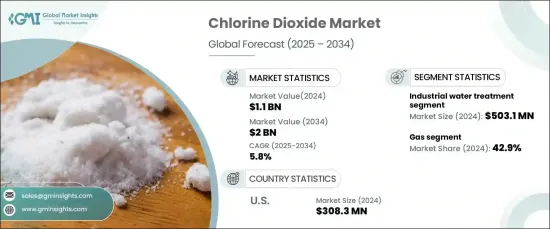
이산화염소 세계 시장은 2024년 11억 달러로 평가되며 2025년부터 2034년까지 연평균 5.8%의 강력한 성장세를 보일 것으로 예상됩니다.
이러한 성장은 주로 수처리, 헬스케어, 식품 가공, 펄프 및 제지 등 여러 산업에서 필수적인 역할을 담당하고 있기 때문입니다. 가장 효과적인 살균제 중 하나인 이산화염소는 트리할로메탄(THM)과 같은 유해한 부산물을 생성하지 않고 광범위한 미생물을 표적으로 삼는 능력이 뛰어나며, 특히 물 정화에 있어 다른 살균제보다 안전한 대안이 되고 있습니다.

효율적이고 친환경적인 수처리 솔루션에 대한 수요가 증가하면서 이산화염소 시장이 확대되고 있습니다. 산업계와 지자체들이 지속가능성에 대한 노력을 기울이면서 환경적으로 안전하고 효과적인 소독제에 대한 수요가 급증하고 있습니다. 이산화염소는 산화제 및 살생물제로서 다양한 용도로 박테리아, 바이러스 및 곰팡이를 퇴치할 수 있는 다목적성을 가지고 있어 위생과 안전을 우선시하는 산업에서 중요한 역할을 하고 있습니다. 또한, 이산화염소의 무해한 부산물, 낮은 환경 영향, 광범위한 pH 범위에서 작동하는 능력으로 인해 이산화염소는 전 세계 정수 공정에서 선호되는 선택이 되고 있습니다.
| 시장 범위 | |
|---|---|
| 시작 연도 | 2024년 |
| 예측 연도 | 2025-2034년 |
| 시작 금액 | 11억 달러 |
| 예상 금액 | 20억 달러 |
| CAGR | 5.8% |
이산화염소 시장은 다양하며, 주요 용도는 산업용 수처리, 식음료, 의료 분야, 펄프 및 제지, 석유 및 가스, 구강 관리, 항공우주, 안과 치료, 섬유 및 농업과 같은 틈새 분야에도 적용됩니다. 산업용 수처리는 2024년 5억 3,100만 달러의 가치를 창출한 주요 부문입니다. 이 분야는 안전 기준을 충족하고 사업의 지속가능성을 보장하기 위해 산업계가 물 정화에 점점 더 많은 초점을 맞추고 있기 때문에 빠르게 성장할 것으로 예상됩니다.
가스, 액체, 고체 등 다양한 형태의 이산화염소가 존재한다는 점도 시장 성장에 기여하고 있으며, 2024년 42.9%로 압도적인 점유율을 차지한 이산화염소 가스 형태는 특히 지자체 수처리, 산업 폐수 정화, 식품 가공 위생에 선호되고 있습니다. 다양한 조건에서 살생물제로서의 효과와 환경 친화적인 특성이 결합되어 살균 처리에 최적의 솔루션으로 자리매김하고 있습니다.
이산화염소의 광범위한 적용 범위와 산업화, 도시화, 지속가능성에 대한 노력의 증가로 인해 이산화염소에 대한 수요는 전 세계적으로 계속 증가할 것으로 예상됩니다. 물의 안전성을 높이고 화학제품에 대한 노출을 줄이기 위한 규제가 강화됨에 따라 산업계는 기존 화학제품에 대한 보다 안전하고 효율적인 대안으로 이산화염소를 찾고 있습니다.
특히 북미 이산화염소 시장은 환경 친화적인 산업 관행으로의 전환, 지자체 수처리 인프라에 대한 대규모 투자, 효율성 개선 및 이산화염소 생산 비용 절감을 위한 연구로 인해 이익을 얻고 있습니다.
The Global Chlorine Dioxide Market was valued at USD 1.1 billion in 2024 and is projected to experience robust growth at a CAGR of 5.8% from 2025 to 2034. This growth is primarily driven by its essential role across several industries, including water treatment, healthcare, food processing, and pulp and paper. As one of the most effective disinfectants, chlorine dioxide stands out for its ability to target a wide range of microorganisms without generating harmful byproducts like trihalomethanes (THMs), making it a safer alternative to other disinfectants, especially in water purification.

The increasing demand for efficient, eco-friendly water treatment solutions is creating an expanding market for chlorine dioxide. As industries and municipalities continue to focus on sustainable practices, the need for environmentally safe, highly effective disinfectants has surged. Chlorine dioxide's versatility as an oxidizing agent and biocide enables it to combat bacteria, viruses, and fungi in a wide variety of applications, positioning it as a key player in industries that prioritize hygiene and safety. Furthermore, chlorine dioxide's non-toxic byproducts, low environmental impact, and ability to function across a broad pH range make it a preferred choice for global water purification processes.
| Market Scope | |
|---|---|
| Start Year | 2024 |
| Forecast Year | 2025-2034 |
| Start Value | $1.1 Billion |
| Forecast Value | $2 Billion |
| CAGR | 5.8% |
The chlorine dioxide market is diverse, with key applications spanning industrial water treatment, food and beverages, medical fields, pulp and paper processing, oil and gas, oral care, aerospace, and eye care, alongside other niches like textiles and agriculture. Industrial water treatment is the leading segment, generating USD 503.1 million in 2024. This sector is set to grow rapidly as industries increasingly focus on water purification to meet safety standards and ensure the sustainability of their operations.
Market growth is also propelled by the different forms of chlorine dioxide available, including gas, liquid, and solid. The gas form of chlorine dioxide, which holds a dominant share of 42.9% in 2024, is particularly favored for municipal water treatment, industrial wastewater purification, and food processing sanitation. Its effectiveness as a biocide in various conditions, combined with its environmentally friendly nature, positions it as the go-to solution for disinfecting processes.
Chlorine dioxide's broad applicability, combined with rising industrialization, urbanization, and sustainability initiatives, ensures that demand for this compound will continue to grow across the globe. As regulations aimed at improving water safety and reducing chemical exposure become more stringent, industries are turning to chlorine dioxide as a safer, more efficient alternative to traditional chemicals.
The chlorine dioxide market, particularly in North America, benefits from a shift toward greener industrial practices, as well as substantial investments in municipal water treatment infrastructure and research aimed at improving efficiency and reducing the chlorine dioxide generation cost.